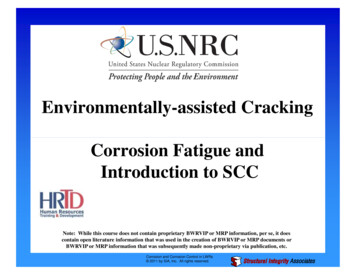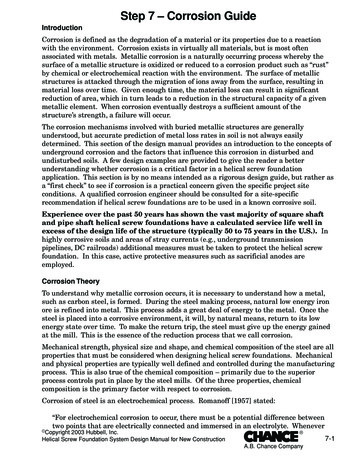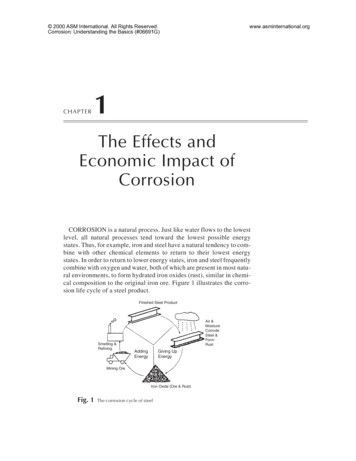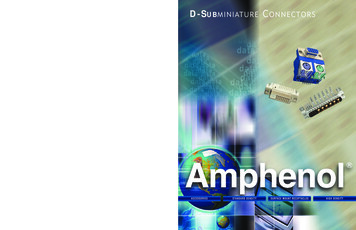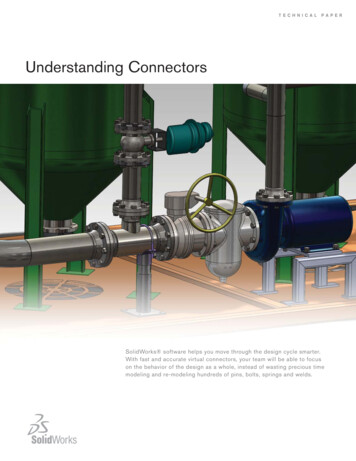
Transcription
Corrosion Protectionfor Metal Connectorsand Fasteners in Coastal Areasin Accordance with the National Flood Insurance ProgramNFIP Technical Bulletin 8 / June 2019
Comments on the Technical Bulletins should be directed to:DHS/FEMAFederal Insurance and Mitigation Administration (FIMA) Risk Management DirectorateBuilding Science Branch400 C Street, S.W., Sixth FloorWashington, DC 20472-3020Technical Bulletin 8 (2019) replaces Technical Bulletin 8 (1996), Corrosion Protection for Metal Connectorsin Coastal Areas for Structures Located in Special Flood Hazard Areas in accordance with the NationalFlood Insurance Program.Cover photographs: Inset photo: Corrosion of galvanized connectors (FEMA, Fire Island, NY, afterHurricane Sandy). Outset photo: Longer strap connectors helped maintain the connection between thebeam and floor joists (FEMA, Seaside Heights, NJ, after Hurricane Sandy).NFIP Technical Bulletin 8 contains information that is proprietary to and copyrighted by the AmericanSociety of Civil Engineers and information that is proprietary to and copyrighted by the International CodeCouncil, Inc. All information is used with permission.For more information, see the FEMA Building ScienceFrequently Asked Questions website at lding-science.If you have any additional questions on FEMA BuildingScience Publications, contact the helpline at FEMABuildingsciencehelp@fema.dhs.gov or 866-927-2104.You may also sign up for the FEMA Building Science emailsubscription, which is updated with publication releasesand FEMA Building Science activities. Subscribe at /subscriber/new?topic id USDHSFEMA 193.Visit the Building Science Branch of the Risk ManagementDirectorate at FEMA’s Federal Insurance and MitigationAdministration at https://www.fema.gov/building-science.To order publications, contact the FEMADistribution Center:Call: 1-800-480-2520(Monday–Friday, 8 a.m.–5 p.m., EST)Fax: 719-948-9724Email: FEMApubs@gpo.govAdditional FEMA documents can befound in the FEMA Library ase scan this QR codeto visit the FEMA BuildingScience web page.
Table of ContentsAcronyms. iii1 Introduction.12 NFIP Regulations.13 Other Regulations.33.1 International Residential Code.33.2 International Building Code and ASCE 24.44 Importance of Selecting Proper Connectors and Fasteners for a Continuous Load Path.65 Light Gauge Metal Connectors and Corrosion.85.1 Known Concerns Related to Nominally Galvanized Metal Connectors.95.2 Metal Connector and Fastener Materials and Fabrication. 116 Causes of Corrosion in Coastal Areas.136.1 Salt Spray from Breaking Waves and Onshore Winds.136.2 Distance from Ocean.136.3 Elevation Above Ground. 146.4 Exposure to Corrosion and Building Orientation. 146.5 Weather and Rates of Corrosion. 146.6 Identifying Areas with Increased Corrosion Rates.157 Exposure Classes for Connectors and Fasteners.157.1 Partially Sheltered Exterior Exposure. 167.2 Open Exposed Exterior Exposure. 167.3 Vented Enclosed Exposures. 167.4 Unvented Enclosed Exposures. 177.5 Interior Living Space Exposures. 178 Improving Corrosion-Resistant Materials and Coatings. 178.1 Thicker Galvanizing. 198.2 Stainless Steel.208.3 Applied Coatings and Paint.20NFIP TECHNICAL BULLETIN 8JUNE 2019i
8.4 Other Corrosion-Resistant Fasteners.219 Guidance for Connector and Fastener Corrosion Control.219.1 Reducing Corrosion Rates.229.2 Maintenance and Replacement Considerations.2410 Summary of Best Practices for Corrosion Resistance.2611 References and Resources.2911.1 References.2911.2 Resources. 31List of FiguresFigure 1:Example of using metal connectors and fasteners to create a continuous load path.7Figure 2: Common wind anchor and metal truss plate.8Figure 3: Common single- and double-joist hangers.8Figure 4: Wood product identification tag. 10Figure 5: Variation in the corrosion rate of steel with elevation at two distances from the oceanfor Kure Beach, NC (LaQue, 1975). 14Figure 6: Corrosion exposure classes and their locations.15Figure 7:Galvanic chart of common metals. 18Figure 8: Approximate service life improvement from increasing galvanization thickness. 19Figure 9: Traditional wooden ledger boards used in place of joist hangers in high corrosion areas.23Figure 11: Wooden wind anchors used to connect floor joists to floor beams.23Figure 10: Detail of an elevated floor-to-beam connection using wood uplift blocking andfull-depth solid blocking.23Figure 12: Zinc galvanizing on connectors that has corroded.25List of TablesTable 1:Comparison of Select 2018 IRC and NFIP Requirements.3Table 2:Comparison of Select 2018 IBC and ASCE 24-14 Requirements with NFIP Requirements.4Table 3:Recommendations on Corrosion-Resistant Materials and Methods.27iiNFIP TECHNICAL BULLETIN 8JUNE 2019
AcronymsANSIAmerican National Standards InstituteASCEAmerican Society of Civil EngineersASTMASTM InternationalAWCAmerican Wood CouncilBFEbase flood elevationCCAchromated copper arsenateCFRCode of Federal RegulationsDHSDepartment of Homeland SecurityFEMAFederal Emergency Management AgencyFIRMFederal Insurance Rate MapIBCInternational Building Code ICCInternational Code Council ICC-ESICC Evaluation ServiceI-CodesInternational Codes IMOAInternational Molybdenum AssociationIRCInternational Residential Code NDSNational Design SpecificationNFIPNational Flood Insurance Programoz/ft2ounces per square footPWFPermanent Wood FoundationSEIStructural Engineering InstituteSFHASpecial Flood Hazard AreaSSPCSociety for Protective CoatingsTPITruss Plate InstituteNFIP TECHNICAL BULLETIN 8JUNE 2019iii
1 IntroductionThis Technical Bulletin explains the importance ofusing corrosion-resistant metal connectors and fastenersin the construction of coastal structures, areas usingpreservative-treated lumber, and any locations subject tocontact with floodwater or windblown rain.Post-disaster assessments of wood-framed buildingsfollowing natural hazard events such as high winds,floods, and earthquakes have revealed that structuralfailures frequently occur at connections rather thanin framing members. In coastal areas, where highermoisture and humidity levels exist and buildings areexposed to salt spray, corroded metal connectors andfasteners have been observed to contribute to the loss ofan adequate load path. The loss of an adequate load pathoften results in damage to or failure of the structure.This Technical Bulletin presents guidance on addressingand avoiding the corrosion of connectors and fasteners.NFIP TECHNICAL BULLETIN 0NFIP Technical Bulletin 0, User’s Guideto Technical Bulletins, should be usedas a reference in conjunction with thisTechnical Bulletin. Technical Bulletin 0describes the purpose and use of theTechnical Bulletins, includes commonconcepts and terms, lists usefulresources, and includes a crosswalkof the sections of the NFIP regulationsidentifying the Technical Bulletinthat addresses each section of theregulations and a subject index.Readers are cautioned that the definitionof some of the terms that are used inthe Technical Bulletins are not the samewhen used by the NFIP for the purposeof rating flood insurance policies.Questions pertaining to minimizing or avoidingcorrosion of connectors and fasteners should be directedto the appropriate product manufacturers, local official,NFIP State Coordinating Office, or the Federal Emergency Management Agency (FEMA) Regional Office.2 NFIP RegulationsAn important National Flood Insurance Program(NFIP) objective is protecting buildings constructedin Special Flood Hazard Areas (SFHAs) from damagecaused by flood forces. The SFHA, composed of ZonesA and V, is the areal extent of the base flood shownon Flood Insurance Rate Maps (FIRMs) prepared byFEMA. The base flood is the flood that has a 1 percentchance of being equaled or exceeded in any given year(commonly called the “100-year flood”).I-CODES AND ASCEThe International Codes (I-Codes) andthe standard, ASCE 24, Flood ResistantDesign and Construction, includerequirements for metal connectors andfasteners used in coastal areas thatare susceptible to salt spray to addressmetal corrosion.The NFIP regulations are codified in Title 44 of theCode of Federal Regulations (CFR) Part 60. Specific tothis Technical Bulletin, in coastal regions, corrosion-resistant connectors and fasteners are essential tomaintaining a building’s load paths and demonstrating compliance with 44 CFR Sections 60.3(a)(3) and60.3(e)(4).NFIP TECHNICAL BULLETIN 8JUNE 20191
Section 60.3(a)(3) is applicable to all SFHAs:If a proposed building site is in a flood-prone area, all new construction and substantialimprovements shall (i) be designed (or modified) and adequately anchored to preventflotation, collapse, or lateral movement of the structure resulting from hydrodynamic andhydrostatic loads, including the effects of buoyancy, (ii) be constructed with materials resistantto flood damage, (iii) be constructed by methods and practices that minimize flood damages Section 60.3(e)(4) is applicable to Coastal High Hazard Areas (Zone V): new construction and substantial improvements [shall be] elevated on pilings andcolumns so that (ii) the pile or column foundation and structure attached thereto isanchored to resist flotation, collapse and lateral movement due to the effects of wind and waterloads acting simultaneously on all building components. Water loading values used shall bethose associated with the base flood. Wind loading values used shall be those required byapplicable State or local building standards.NFIP REQUIREMENTS AND HIGHER REGULATORY STANDARDSState and Local Requirements. State or local requirements that are more stringent than the minimumrequirements of the NFIP take precedence. The Technical Bulletins and other FEMA publications provideguidance on the minimum requirements of the NFIP and describe best practices. Design professionals,builders, and property owners should contact local officials to determine whether more restrictiveprovisions apply to buildings or sites in question. All other applicable requirements of the State or localbuilding codes must also be met for buildings in flood hazard areas.Substantial Improvement and Substantial Damage. As part of issuing permits, local officials mustreview not only proposals for new construction but also for work on existing buildings to determinewhether the work constitutes Substantial Improvement or repair of Substantial Damage. If the work isdetermined to constitute Substantial Improvement or repair of Substantial Damage, the buildings mustbe brought into compliance with NFIP requirements for new construction. Some communities modify thedefinitions of Substantial Improvements and/or Substantial Damage to be more restrictive than the NFIPminimum requirements.For more information on Substantial Improvement and Substantial Damage, see FEMA P-758, SubstantialImprovement/Substantial Damage Desk Reference (2010b), and FEMA 213, Answers to Questions AboutSubstantially Improved/ Substantially Damaged Buildings (2018a).Flood Damage-Resistant Materials. Guidance on the NFIP requirement regarding the use of buildingmaterials resistant to flood damage can be found in Technical Bulletin 2, Flood Damage-ResistantMaterials Requirements.2NFIP TECHNICAL BULLETIN 8JUNE 2019
3 Other RegulationsIn addition to complying with NFIP requirements, all new construction, Substantial Improvements, andrepair of Substantial Damage must comply with applicable building codes and standards that have beenadopted by States and communities.The International Codes (I-Codes ), published by the International Code Council (ICC ) are a familyof codes that includes the International Residential Code (IRC ), International Building Code (IBC ),International Existing Building Code (IEBC ), and codes that govern the installation of mechanical,plumbing, fuel gas service, and other aspects of building construction. FEMA has deemed that thelatest published editions of the I-Codes meet or exceed NFIP requirements for buildings and structures.Excerpts of the flood provisions of the I-Codes are available on FEMA’s Building Code Resource s).3.1 International Residential CodeThe IRC applies to one- and two-family dwellings and townhomes not more than three stories above gradeplane, with certain limitations for high wind, high seismic, and high snow regions. The IRC requirementsthat are related to connectors and fasteners in coastal areas are summarized in Table 1.Although Table 1 refers to selected requirements of the 2018 IRC and notes changes from the 2015 and2012 editions, subsequent editions should include comparable requirements.Table 1: Comparison of Select 2018 IRC and NFIP RequirementsSummary of Select 2018 IRC Requirements andChanges from 2015 and 2012 EditionsTopicFasteners andconnectorsSection R317.3.1 Fasteners for preservative-treated wood.Comparison withNFIP RequirementNo NFIP requirementRequires all fasteners used for pressure-treated wood to be corrosionresistant. Specific requirements for connectors are outlined in the IRC.The coating type and weights of connectors shall either be as specified bythe manufacturer or meet the minimum requirements as specified in theIRC. Exceptions to this requirement are outlined in the IRC.Change from 2015 to 2018 IRC: The need for staples to be stainless steelwas added.Change from 2012 to 2015 IRC: No changes.Flood-resistantconstructionSection R322.1.2 Structural systems.Requires that buildings and structures be designed and constructed toresist flood forces during a design flood event. This includes connectingstructural systems and anchoring the building to resist flotation, collapseor permanent lateral movement during a design flood.Equivalent to NFIPregulation in 44 CFR§§ 60.3(a)(3)(i) and(iii), and § 60.3(e)(4)Changes from 2015 to 2018 IRC: No change.Changes from 2012 to 2015 IRC: No change.NFIP TECHNICAL BULLETIN 8JUNE 20193
Table 1: Comparison of Select 2018 IRC and NFIP Requirements (concluded)Summary of Select 2018 IRC Requirements andChanges from 2015 and 2012 EditionsTopicFlood damageresistantmaterialsSection R322.1.8 Flood-resistant materials.Requires materials used below the required design flood elevation to beflood damage resistant in conformance with NFIP Technical Bulletin 2.Comparison withNFIP RequirementEquivalent to NFIPregulation in 44 CFR§ 60.3(a)(3)(ii)Change from 2015 to 2018 IRC: No change.Change from 2012 to 2015 IRC: The need for wood to be pressure-treated,preservative-treated, or decay-resistant heartwood was deleted to clarifythat the guidance in NFIP Technical Bulletin 2 is adequate to meet flooddamage-resistant material requirements.Used with permission from ICC.3.2 International Building Code and ASCE 24The flood provisions in the latest published editions of theIBC meet or exceed the NFIP requirements for buildingsIBC AND ASCE COMMENTARIESlargely through reference to the standard ASCE 24, FloodICC publishes companionResistant Design and Construction, developed by the Americancommentary for the IBC and ASCESociety of Civil Engineers (ASCE). The IBC applies to allpublishes companion commentaryapplicable buildings and structures. While primarily usedfor ASCE 24. Although notfor buildings and structures other than dwellings within theregulatory, the commentaries providescope of the IRC, the IBC may be used to design dwellings.information and guidance that areThe IBC and ASCE 24 requirements related to the use ofuseful in complying with, interpreting,corrosion-resistant fasteners (often used for maintaining aand enforcing requirements.building load path), which are summarized in Table 2, aremore specific than NFIP regulations and also apply to areaswhere the minimum elevation requirements are above the base flood elevation (BFE) by the incorporationof freeboard.Although Table 2 refers to selected requirements of the 2018 IBC and ASCE 24-14 (noting changes from2015 and 2012 IBC and ASCE 24-05), subsequent editions should include comparable requirements.Table 2: Comparison of Select 2018 IBC and ASCE 24-14 Requirements with NFIP RequirementsTopicGeneral designrequirementSummary of Select 2018 IBC/ASCE 24-14 Requirements andChanges from 2015 and 2012 IBC/ASCE 24-052018 IBC, Section 1612.2 Design and construction.Requires buildings and structures located in all delineated flood hazardareas to be designed and constructed in accordance with Chapter 5 ofASCE 7 (Minimum Design Loads and Associated Criteria for Buildings andOther Structures) and ASCE 24.Change from 2015 to 2018 IBC: Section renumber from 1612.4 to 1612.2.Change from 2012 to 2015 IBC: Applies to coastal high hazard arearequirements in Coastal A Zones, if delineated.4Comparison withNFIP RequirementFor Zones A and V,equivalent to NFIP44 CFR § 60.3For Coastal A Zones,more restrictive thanthe NFIP since theNFIP does not defineCoastal A ZonesNFIP TECHNICAL BULLETIN 8JUNE 2019
Table 2: Comparison of Select 2018 IBC and ASCE 24-14 Requirements with NFIP Requirements (continued)Summary of Select 2018 IBC/ASCE 24-14 Requirements andChanges from 2015 and 2012 IBC/ASCE 24-05TopicFasteners andconnectors forpreservativetreated wood2018 IBC, Section 2304.10.5 Fasteners and connectors in contactwith preservative-treated and fire-retardant-treated wood.Fasteners andconnectors forpreservativetreated wood(cont.)2018 IBC, 2304.10.5.1 Fasteners and connectors for preservativetreated wood.Comparison withNFIP RequirementNo NFIP requirementRequires all fasteners used for pressure-treated and fire-retardant-treatedwood to be corrosion resistant and shall be compliant with Sections2004.10.5.1 through 2304.10.5.4. Coating requirements for zinc coatingsand stainless steel fasteners are specified in the IBC.No NFIP requirementRequires all fasteners used for pressure-treated wood to be corrosionresistant. Specific requirements for connectors are outlined in the IBC.The coating type and weights of connectors shall either be as specified bythe manufacturer or meet the minimum requirements as specified in theIBC. An exception for carbon steel fasteners is outlined in the IBC.2018 IBC, 2304.10.5.2 Fastenings for wood foundations.Requires all fasteners used for wood foundations to be compliant withthe American Wood Council’s Permanent Wood Foundation DesignSpecification with Commentary, 2015 Edition (ANSI/AWC PWF-2015[2014b]).2018 IBC, 2304.10.5.3 Fasteners for fire-retardant-treated wood usedin exterior applications or wet or damp locations.Requires all fasteners used for fire-retardant-treated wood in exteriorapplications or wet or damp locations to be corrosion resistant. Specificrequirements for fasteners are outlined in the IBC.2018 IBC, 2304.10.5.4 Fasteners for fire-retardant-treated wood usedin interior applications.Requires all fasteners used for fire-retardant-treated wood in interiorlocations to be as specified by the manufacturer, or if those specificationsdo not exist, the fasteners meet the requirements of Section 2304.9.5.3.Changes from 2015 to 2018 IBC: Standards for driven fasteners and theneed for staples to be stainless steel were added.Changes from 2012 to 2015 IBC: Section 2304.9.5 was renumbered to2304.10.5.Flood damageresistantmaterialsASCE 24-14, Section 5.1 GeneralRequires that, in flood hazard areas, all materials used in new constructionand substantial improvaements be constructed of flood damage-resistantmaterials below the required elevations specified in Table 5-1 of ASCE24-14. Also requires materials to be of sufficient strength, rigidity, anddurability to adequately resist all flood-related and other loads or to bedesigned as breakaway or as otherwise permitted in the standard.Equivalent to NFIP44 CFR § 60.3(a)(3)with more specificityon requirementsfor connectors andfastenersChange from ASCE 24-05: Duplicative statement at the end of the sectionon the need for materials to have sufficient strength, rigidity, and durabilityto resist flood loads was removed.NFIP TECHNICAL BULLETIN 8JUNE 20195
Table 2: Comparison of Select 2018 IBC and ASCE 24-14 Requirements with NFIP Requirements (concluded)TopicMetalconnectors andfastenersSummary of Select 2018 IBC/ASCE 24-14 Requirements andChanges from 2015 and 2012 IBC/ASCE 24-05ASCE 24-14, Section 5.2.1 Metal Connectors and FastenersComparison withNFIP RequirementNo NFIP requirementRequires that metal connectors and fasteners exposed to floodwater,precipitation, or wind-driven water meet specific standards as outlined inASCE 24-14 for corrosion resistance.Change from ASCE 24-05: Updated references to materials standards.ASCE 24-14, Section 5.2.2.1 Corrosive EnvironmentsRequires structural steel exposed to saltwater, salt spray, or othercorrosive materials be hot-dipped galvanized after fabrication and othersecondary components to meet the requirements of Section 5.2.1.Change from ASCE 24-05: No change.Used with permission from ICC and ASCE.4 Importance of Selecting ProperConnectors and Fastenersfor a Continuous Load PathBuildings are exposed to numerous forces (loads), including those associated with wind events, floods,snow accumulation, and earthquakes. For a building to survive exposure to such forces, loads must betransferred through the building’s structure to the soils that support the building along what are typicallyreferred to as load paths. Load paths consist of structural elements (e.g., beams, columns, bearing walls)and the components that connect these elements. In light-frame construction, structural elements areoften connected with metal connectors and fasteners (fasteners include screws, bolts, and nails). Examplesare shown in Figure 1.Metal connectors are premanufactured components that are usually cut from flat steel sheets and formedinto a shape to efficiently transfer loads from one structural element to another. The load capacities ofmetal connectors, often determined by the manufacturer through testing or analysis, are published foruse by design professionals and contractors to meet the load requirements for their project.Metal connectors and fasteners are important elements in transferring loads from natural hazards (e.g.,flood, wind, seismic) through a building. Corrosion rates for metal are dramatically higher in coastalenvironments than in less harsh, non-coastal environments. Therefore, it is important to increase thecorrosion protection for metal connectors and fasteners in coastal environments. See Section 6 forinformation on the causes of corrosion in coastal areas. Studies have shown that stainless steel andthick hot-dip galvanized (G185 or higher) metal connectors and fasteners improve corrosion protection.Selecting metal connectors and fasteners made of the same metal and either hot-dip galvanized orstainless steel will improve performance. See Section 8 for information on improving corrosion resistance.6NFIP TECHNICAL BULLETIN 8JUNE 2019
Regardless of the metal that is selected, routine inspection is important to identify when replacement isnecessary. See Section 9.2 for information on inspections.Preservative-treated lumber, which is commonly used in many buildings, requires special attention whenselecting connectors and fasteners. See Section 5.1.1.Figure 1: Example of using metal connectors and fasteners to create a continuous load pathNFIP TECHNICAL BULLETIN 8JUNE 20197
5 Light Gauge Metal Connectorsand CorrosionThe term “light gauge metal connectors” is used in this Technical Bulletin to highlight the importanceof corrosion protection for lighter gauge connectors such as the prefabricated connectors that are usedto facilitate wood connections. However, metal connectors fabricated from thicker steel will also benefitfrom this guidance.Light gauge metal connectors are commonly used in several locations throughout wood-framed buildings.Concrete and masonry structures may also use them. Although light gauge metal connectors are notunique to wood-framed buildings, this Technical Bulletin highlights aspects of using them in woodframed buildings in areas where corrosion can occur.Light gauge metal connectors are often used to create a load path by securing roof framing to the tops ofload-bearing walls, connecting walls of upper floors to lower floors, and connecting walls to foundations.The selection of the type of metal connector to use for specific applications may be dictated by thebuilding code or may be based on the relative ease a type of connector offers in making complex framingconnections. Metal connectors such as wind anchors may be used instead of toe-nailed connections toincrease the strength of connections of a roof truss to a top plate (see Figure 2). In some cases, suchas when attaching floor joists to floor band joists, metal connectors can both improve the connectionand also reduce labor costs (see Figure 3). In some portions of a building’s load path, light gauge metalconnectors can make the connection several times stronger than a connection that is readily achievableby nails alone.Figure 2: Common wind anchor and metal truss plate8Figure 3: Common single- and double-joist hangersNFIP TECHNICAL BULLETIN 8JUNE 2019
Despite the benefit of being stronger than nails alone, light gauge metal connectors have drawbacksin coastal environments. Metal connectors that are prone to corrosion can lead to load path failuresand structural da
on Flood Insurance Rate Maps (FIRMs) prepared by FEMA. The base flood is the flood that has a 1 percent chance of being equaled or exceeded in any given year (commonly called the "100-year flood"). The NFIP regulations are codified in Title 44 of the . Code of Federal Regulations (CFR) Part 60. Specific to
